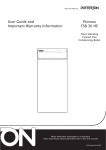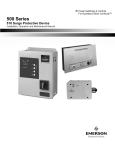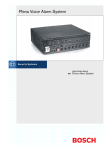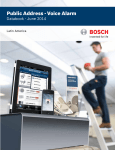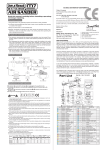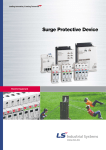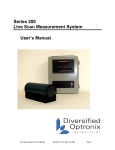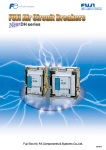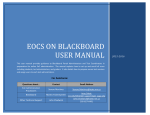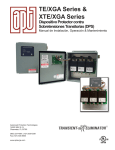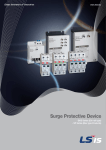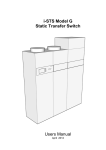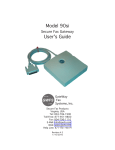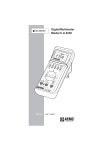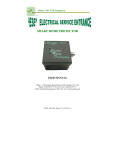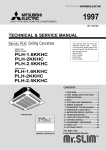Download CG_plus IOM.qxd
Transcript
Installation,Operation and Maintenance Manual PN 750-0100-001 JSP JSP J JSP JSP JSP ™ ® JSP™ Installation, Operation and Maintenance Manual Surge Protective Devices Table of Contents Installation Assistance 3 Importance of Correct Installation 3 Warnings 3 Before Installation 4 System Configuration Verification 4 Environmental Condition Verification 4 Wiring Connection Diagram 5-6 Single Phase 2-Wire 5 Split-Phase, 3-Wire 5 3-Phase, 4-Wire WYE 5 3-Phase, 3-Wire DELTA 5 3-Phase, 4-Wire High-Leg DELTA 6 Conductor Routing 6 Upstream Over-Current Protection Device 6 Conductor Sizing 7 Mounting 7 Conduit Openings and Enclosure / Mounting Dimensions 2 7-8 Electrical Connections 8 Connecting Form C Dry Contacts 9 Verification and Power Up 10 Troubleshooting 11 Technical Assistance 11 Return and Warranty Procedures 11 Warranty Statement 12 JSP™ Installation, Operation and Maintenance Manual Installation Assistance Thank you for choosing the Joslyn® JSP™ series Surge Protective Device (SPD). We look forward to fulfilling your facility-wide surge protection needs. Monday through Friday, 8:00 a.m. to 5:00 p.m. (EST) at 800.238.5000. The Importance of Correct Installation This manual provides guidelines for the proper installation of the JSP family of devices. Proper product selection and compliance with these guidelines will help your new suppression system provide years of reliable service. If installers are unsure about the facility electrical configuration or have other installation-related questions, it is recommended they consult with a master electrician or other qualified electrical professional. When shortcuts are taken or installation procedures are not followed, the JSP system may be damaged or may not provide adequate protection. It is extremely important to follow these installation procedures carefully. WARNINGS! ! ! WARNING! The JSP™ warranty is voided if the unit is damaged as a result of improper installation or the installer’s failure to verify the following conditions prior to installation. WARNING! HAZARDOUS VOLTAGES PRESENT Improper installation or misapplication may result in serious personnel injury/or damage to the electrical system. Read the complete installation instructions before proceeding with installation. Remove all power to the electrical panel before installing or servicing the surge protective device (SPD). IMPORTANT SAFETY INSTRUCTIONS All work must be performed by licensed and qualified personnel. The electrical system must be properly grounded in accordance with the U.S. National Electrical Code, state and local codes or other applicable codes for this SPD to function properly. This device is suitable for installation where the available short circuit current is 200,000 rms symmetrical amperes up to 600VAC or less. For countries outside of the US follow applicable electrical specifications for the electrical specifications for the country the unit is being used in. ! JSP™ Installation, Operation and Maintenance Manual This Statement is only applicable for TNCS grounded systems. WARNING! Check to ensure that a proper bond is installed between neutral and ground at the transformer upstream from all 3-phase WYE, 3-phase high leg DELTA or split-phase JSP device (See NEC Article 250). If the transformer is not accessible, check the main service disconnect/panel for the NG bond. Lack of a proper bond will damage JSP and void the warranty. 3 Before Installation: System Configuration Verification Confirm that the voltage(s) and service configuration shown on the JSP product label are consistent with the voltage and service configuration of the facility. A model number is on the right side of the JSP unit. Each model number corresponds to the configurations printed in the table below: Example of a SPD model number: JSP160-3Y208-F MODEL NOMINAL VOLTAGE L-N VOLTAGE RANGE L-L VOLTAGE RANGE CONFIGURATION JSPxxx-1P120* 120 90-132 90-132 Single Phase 2-wire+ground JSPxxx-1P240* 240 180-264 180-264 Single Phase 2-wire+ground JSPxxx-1S240* 120/240 90-132 180-280 Split-Phase 3-wire+ground JSPxxx-3Y208* 120/208 312-382 540-660 Three-Phase 4-wire+ground JSPxxx-3Y380* 220/380 198-253 342-440 Three-Phase 4-wire+ground JSPxxx-3Y415* 240/415 216-264 373-457 Three-Phase 4-wire+ground JSPxxx-3Y480* 277/480 249/305 432-528 Three-Phase 4-wire+ground JSPxxx-3H240* 120/240 108-132(A, C) 187-229 (B) JSPxxx-3Y600 347/600 313-394 540-660 Three-Phase WYE 4-wire+ground JSPxxx-3D240* 240 N/A 216-264 Three-Phase DELTA 3-wire+ground JSPxxx-3D380 380 N/A 342-418 Three-Phase DELTA 3-wire+ground JSPxxx-3D480 480 N/A 432-528 Three-Phase DELTA 3-wire+ground JSPxxx-3D600 600 N/A 540-660 Three-Phase DELTA 3-wire+ground 216-264 Three-Phase High-Leg 4-wire+ground xxx denotes surge rating per phase (60, 80, 100, 120, 160, 200, 240, 300, 400) * These are the only voltages available on the 60, 80, and 100kA systems Environmental Condition Verification 4 Confirm that the environmental conditions are consistent with the following ranges: • Ambient Temperatures: Between -40° and +158°F (-4.5 to 70º C). • Relative Humidity: Between 5% and 95% non-condensing. • Altitude: Less than 13,000 feet (4000m). JSP™ Installation, Operation and Maintenance Manual Wiring Connection Diagrams Figures 1-4 show the electrical relationship between JSP and these five basic service TNCS grounded configurations: Single phase, 2-wire; Split-phase, 3-wire; Three-phase, 4-wire WYE; Three-phase, 3-wire DELTA and Three-phase, Fig. 1: Single Phase, 2-Wire TVSS Fig. 2: Split-Phase, 3-Wire TVSS Fig. 3: 3-Phase, 4-Wire WYE Fig. 4: 3-Phase, 3-Wire DELTA TVSS TVSS JSP™ Installation, Operation and Maintenance Manual 5 Fig.5: 3-Phase, 4-Wire High-Leg DELTA TVSS Conductor Routing ! CAUTION: JSP’s performance will be limited severely if the conductors are (a) too long, (b) are of too small a wire gauge, (c) have too many bends or (d) have sharp bends. For optimum performance never exceed 10’. The factors listed above should be addressed during the design of an installation to reserve a suitable place for JSP next to its point of connection to the electrical system. The selected mounting location should allow for the shortest possible conductor runs and a direct route with a minimum of bends. If bends are required, they should be sweeping bends (12” radius). Do not make sharp 90° bends for appearance purposes because they will severely decrease the effectiveness of JSP. Binding or twisting conductors together using tie-wraps or electrical tape increases the protection performance of the device. Upstream Over-Current Protection Device The JSP has been listed to UL1449 as a Type 1 SPD. Type 1 SPDs can be used in Type 1 or Type 2 SPD applications, which means that the JSP does not need to be connected behind an upstream over current protection device and can be connected on either the line or load side of the main service disconnect. The JSP must be connnected in parallel with the electrical system. All JSP units come standard with component-level over-current fusing rated at 200,000 rms symmetrical amperes at 600VAC and can be connected directly to the electrical distribution system bus without an upstream over-current protection device (OCPD). If installing as a Type 2 SPD the use of an external OCPD is recommended. If the SPD is connected to a dedicated OCPD, a 60A breaker is recommended (30A minimum, 200A maximum). The advantage of using a dedicated over-current device for the SPD (even if the upstream breaker is 200A or less) is that it allows the SPD to be de-energized during service without disturbing the electrical service to the rest of the facility. 6 JSP™ Installation, Operation and Maintenance Manual Conductor Sizing Joslyn recommends installing JSP by using the following conductor size for phase, ground and neutral connections. The conductor length should be as short as possible to ensure the maximum level of protection. Use a larger conductor (not to exceed the maximum allowed per a given model) where space and bending radii permit. Example of a SPD model number: JSP160-3Y208-FB PRODUCT LABEL DESIGNATION SURGE CURRENT CAPABILITY JSP60 60kA/phase1 #10AWG #10AWG #10AWG JSP80 80kA/phase1 #10AWG #10AWG #10AWG JSP100 100kA/phase1 #10AWG #10AWG #10AWG JSP120 120kA/phase1 #10AWG #3AWG #10AWG JSP160 160kA/phase #10AWG #3AWG #10AWG JSP200 200kA/phase2 #3AWG #3AWG #10AWG JSP240 240kA/phase2 #3AWG #3AWG #10AWG JSP300 300kA/phase2 #3AWG #3AWG #10AWG CONDUCTOR SIZE RECOMMENDED MAXIMUM MINIMUM 1 JSP400 400kA/phase #3AWG #3AWG #10AWG 60through 100kA units are shipped with #10AWG leads. Leads should be shortened during installation in order to minimize conductor length. 120 through 400kA units are shipped with compression box lugs. 2 1 2 Mounting Mount the JSP to the building structure using construction methods and hardware appropriate for your site. Install the conduit and pull the conductors as specified above or according to the engineer’s design. Conduit Openings If desired, punch holes at this time for the conduit or nipple or wait until the JSP is mounted to the building structure. Punch holes only in the designated areas as shown in the following illustration. ! CAUTION: Careful consideration must be made when selecting an area for conduit entry. There are several components inside the enclosure that may interfere with the conduit entry path, therefore, ensure the path is clear of all objects before drilling. Damages caused by installation errors are not covered under the product warranty. See Fig. 5 for conduit openings and enclosure dimensions. JSP™ Installation, Operation and Maintenance Manual 7 Fig. 5: Conduit Openings and Enclosure/Mounting Dimensions (W1) 2"0 3. .8mm) (D) (W2) 3 (8 3"6 1.4.5mm) ø0.31 (3 (7.87) (H1) A (H2) (H3) (W1) 2"0 3.3.8mm) (D) 3"6 1.4.5mm) (W2) (8 ø0.31 (3 (7.87) C ALLOWA BLEAREA FOR COND UITENTRY (H1) (H2) (H3) B ALLOWA BLEAREA FOR COND UITENTRY A B C Dim JSP60, 80, 100 JSP120, 160 JSP200, 240, 300, 400 H1 6.00 (152.4) 10.00 (254.0) 14.00 (355.6) H2 6.75 (171.5) 10.75 (273.1) 14.75 (374.7) H3 7.50 (190.5) 11.50 (292.1) 15.50 (393.7) W1 6.00 (152.4) 8.00 (203.2) 12.00 (304.8) W2 4.00 (101.6) 6.00 (152.4) 10.00 (254.0) D 4.16 (105.7) 6.20 (157.5) 6.20 (157.5) Weight 12.0 (5.4) 27.0 (12.2) 40.0 (18.2) All measurements in inches (mm) and pounds (kg) Electrical Connections ! CAUTION: Prior to installation ensure the system configuration and voltage is equivalent to the JSP unit being installed. Following all applicable National Electrical Code standards as well as state and local codes, connect phase, neutral* and ground to JSP. The 60kA, 80kA and 100kA units come with 36 inches of #10 AWG conductors. Each phase conductor is labeled (Phase A, B or C). The 120kA, 160kA, 200kA, 240kA, 300kA and 400kA units come with compression box lugs. The installer must provide the appropiate conductors. Ensure that the conductor lengths are kept as short and straight as possible. On all high-leg delta systems, the high-leg (208V L-N) must be connected to the Phase B of the SPD. (color-coded orange according to NEC). * The 3-wire plus ground Delta JSP does not have a neutral conductor. 8 JSP™ Installation, Operation and Maintenance Manual Connecting Form C Dry Contacts All JSP units (option -M for 60kA, 80ka, and 100kA) come standard with one set of Form "C" dry relay contacts for the surge protective device status. These contacts are for connection to a user-provided remote alarm and monitoring circuit. The relay contacts are rated 150VDC/125VAC with maximum switching power of 30WDC/60VA AC. See Figure 6 for the form C contact configuration and terminal location on the monitor board. The annotations on the diagram match the markings on the terminal block. When input power is present on all phases, terminals “NO” and “COM” are an open circuit and terminals “NC” and “COM” are a closed circuit. The contacts change state when the unit has encountered failure to one or more phases. The installer must provide the appropriate raceway and wiring for the monitoring circuit, observing the restrictions and conduit openings illustrated in an earlier section of this manual. The installer must route the monitoring conductors to the terminal blocks on the doormounted main monitoring board. Route the wires to allow the door to be opened and closed properly. Tighten screws on terminals to 3.5 in-lbs (0.4 Nm). This terminal block will accept wire sizes #28AWG to #16AWG. #18 – #20 AWG is recommended. Fig. 6 Remote Monitoring Terminal Block Contacts shown in energized normal state (no fault condition). COVER EAR VIEW JSP™ Installation, Operation and Maintenance Manual 9 Verification and Power Up ! Fig. 7 JSP Diagnostics WARNING: It is recommended that the cover of the JSP unit along with its associated cabling be installed prior to applying power. The monitoring harness, which exits the epoxy and connects to J2 on the monitor board, contains line voltage when power is applied to the unit. Apply power to JSP by closing the over-current protection device or switch feeding the suppressor. For Compact JSP Units (60, 80, and 100kA units) Verify that all “Protection Available” indicating lights are illuminated. The “Protection Available” indicating light extingush only upon failure of one or more phases (indicating an alarm condition). R For Standard JSP Units (120, 160, 200, 240, 300, and 400) or -M (60, 80 and 100kA) Verify that all “Protection Available” indicating lights are illuminated. The “Protection Available” lights extingush only upon failure of one or more phases (indicating an alarm condition). Audible alarm should not operate under normal conditions. The audible alarm can be “muted” by pressing the “ALARM SILENCE” button, which subsequently will illuminate the “ALARM SILENCED” light. Pressing the “ALARM SILENCE” button again will enable the audible alarm. R CAUTION: Pressing the “ALARM SILENCE” button when the alarm has not triggered will prevent the audible alarm from sounding during a failure. Fig. 8 JSP with Counter Option Diagnostics For JSP Units with surge counter option (Not available on 60, 80 and 100kA) The number of surges detected by the SPD is displayed on an eightdigit LCD display on the front of the JSP door. The LCD counter is battery backed to maintain the number of surges even during a power loss. Press the reset button on the counter to reset the surge count. R 10 JSP™ Installation, Operation and Maintenance Manual Troubleshooting Your JSP system does not require scheduled maintenance. The unit’s heavyduty construction is designed to provide years of uninterrupted service. The unit contains no serviceable parts. INDICATION One or more phase protection status indicating lights are off, service required indicating light is on, or form C alarm contacts have changed state PROCEDURE Verify that the input power feeding JSP is energized using a voltage tester. If power is present, contact factory for assistance: 800-238-5000 Technical Assistance Our staff is ready to support you and answer any questions. Monday through Friday, 8:00 a.m. to 5:00 p.m. (EST) at 800-238-5000 Returns and Warranty Procedures JSP units are warranted for a period of 10 years from date of purchase. In the event that any module or subassembly within the SPD fails to perform as specified during the warranty period, call our Technical Support at 800-238-5000. A Return Material Authorization (RMA) number must be obtained from the company’s Customer Service department before replacement products can be shipped. Go to www.joslynsurge.com to complete an online return material authorization request form. We will immediately ship a replacement for the defective parts free of charge (installation labor and site preparation excluded). Return the defective parts to Joslyn within 30 days of receiving the replacement. Failure to return the defective parts will result in billing for the replacement parts. To help expedite the return procedures, please have the following information at hand when you contact Joslyn: INFORMATION JSP™ Installation, Operation and Maintenance Manual EXAMPLE Model Number JSP120-277/480-3GY Serial Number 15478-0105-001 Date of Purchase January 2, 2005 (1st week) Description of Failure “Service Required” indicating light illuminated Desired Action from Joslyn Replace 11 Warranty Statement Joslyn warrants that your Joslyn surge protective device (the "Product"), shall meet applicable industry standards and specifications and be free from defects in materials and/or workmanship. Should any failure of the Product to conform to this warranty appear within the standard warranty period, Joslyn shall either repair or replace the defective Product, or part thereof, upon return to Joslyn manufacturing facility in Richmond, Virginia with transportation charges prepaid. The applicable warranty period as outlined herein. Joslyn shall have no liability under this warranty for any problems or defects directly or indirectly caused by misuse of the Product, alteration of the Product (including removal of any warning labels), accidents, or improper installation, application, operation, or repair of the Product. THIS WARRANTY REPRESENTS THE ENTIRE WARRANTY OF JOSLYN. ALL OTHER WARRANTIES, EXPRESS OR IMPLIED, ORAL OR WRITTEN, INCLUDING, BUT NOT LIMITED TO, THE WARRANTIES OF MERCHANTABILITY AND FITNESS FOR A PARTICULAR PURPOSE ARE HEREBY DISCLAIMED. The liability of Joslyn under this warranty is expressly limited to the replacement or repair of the defective part thereof, at Joslyn sole option. IN NO EVENT SHALL JOSLYN BE LIABLE FOR SPECIAL, INCIDENTAL, OR CONSEQUENTIAL DAMAGES OF ANY KIND OR CHARACTER, NOR SHALL JOSLYN’ LIABILTY EVER EXCEED THE PURCHASE PRICE PAID FOR SUCH DEFECTIVE PRODUCT. This warranty is not transferable and may only be enforced by the sole purchaser. Claims under this warranty must be submitted to Joslyn within thirty (30) days of discovery of any Joslyn product defect. ® ©2009 Joslyn and JSP™. 12 Joslyn 5900 Eastport Boulevard Richmond, VA 23231-4453 Tel: 804.236.3300 800.238.5000 Printed in U.S.A. All Rights Reserved. PN 750-0100-001 JSP™ Installation, Operation and Maintenance Manual












